As a passionate outdoor enthusiast, I’ve spent considerable time canoeing, rafting, and recently delving into the world of kayaking. However, amidst the rushing rivers and tranquil lakes, I discovered an unfamiliar yet critical issue I had never encountered before − oil canning in kayaks. To my surprise, many kayaking enthusiasts are unaware of the significance of this phenomenon, which may lead to not only hampering their kayaking experience but ultimately their kayak’s performance and lifespan. As someone who appreciates the versatile nature of kayaking, I felt compelled to share what I’ve learned about oil canning, the impact it has on our watercraft, and how we can manage it effectively.
This comprehensive guide about oil canning will provide you with a robust understanding of what it entails, how it occurs, and the ways to fix and prevent it. So, shall we embark on a journey to dive into the depths of the mysterious oil canning kayak phenomenon? Let’s grab our paddles and gear up for an adventure in exploring the intricacies of our cherished kayaks.
Contents
Contents
Discovering The Oil Canning Phenomenon
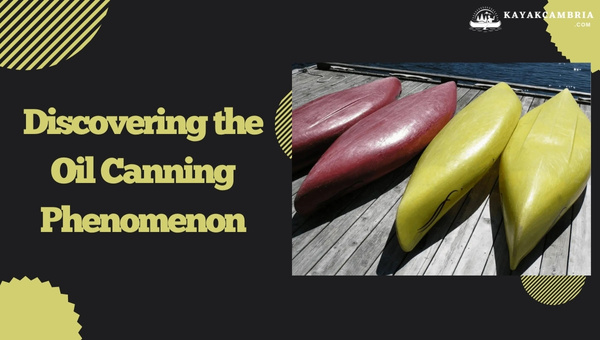
As I ventured into the kayaking world, I quickly discovered that oil canning is a common concern among enthusiasts. So, what exactly is oil canning? Oil canning refers to the noticeable indentations or distortions in a kayak’s hull, which resemble an oil can’s flexible sides. These deformations can be caused by various factors, and it’s essential to be able to identify them to ensure a better kayaking experience.
Why Does Oil Canning Occur?
There are several reasons behind the occurrence of oil canning in kayaks:
- Manufacturing process: The process used while manufacturing kayaks, especially those made from thermoplastic materials, can cause slight imperfections or deformities that result in oil canning.
- Heat exposure: Extended exposure to direct sunlight or excessive heat can cause the plastic hull material to warp, leading to oil canning.
- Improper storage: Storing a kayak flat on the ground or suspending it inappropriately can put uneven pressure on the hull, resulting in eventual distortion.
- Transportation stress: Poorly secured kayaks during transportation can cause stress points, which may lead to distortion in the hull.
Identifying Oil Canning in a Kayak
To spot oil canning in a kayak, one must carefully examine the hull of the vessel. If the hull material appears to be pushed inward or outward, forming uneven ridges or valleys, you have likely discovered an instance of oil canning. It’s crucial to stay vigilant and keep an eye on these deformations to ensure they don’t worsen and impede the performance of your kayak.
By understanding the oil canning phenomenon and its causes, one can learn to address it effectively and maintain their kayak’s performance on the water.
The Implications Of Oil Canning
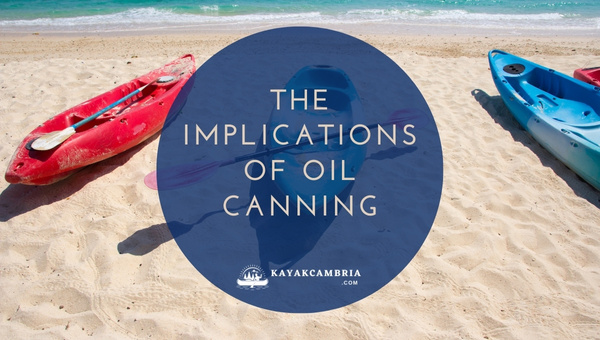
Oil canning may seem like a minor blemish on your kayak, but its impact on performance and durability can be significant. Here are some aspects to consider when facing the challenge of oil canning.
Decreased Performance and Efficiency in Water
A hull that is oil canned will not glide as smoothly through the water as it should. This is due to the uneven surface, which increases water resistance and causes turbulence. The result is a slower kayak and an inefficient paddling experience, requiring more effort from you to maintain your desired speed.
Potential Stress Points that May Lead to Cracks
Oil canning causes the hull material to flex and deform, creating stress points. Over time, these stress points may weaken and develop into cracks, compromising the structural integrity of your kayak. Depending on the extent of the damage, this may even render your kayak unsafe to use.
Reduced Lifespan of the Kayak
Regular use of an oil canned kayak will accelerate normal wear and tear. This is especially true if you often paddle in rough conditions or use your kayak for white-water adventures. The constant pressure faced by the hull combined with the compromised structural integrity caused by oil canning will inevitably shorten your kayak’s lifespan.
Understanding the implications of oil canning is essential to help you make informed decisions on whether to repair, replace, or simply adjust your kayaking expectations. Keep in mind, though, that investing in proper storage, transportation, and maintenance can alleviate many of these issues and keep your kayak in tip-top shape for years to come.
How To Fix An Oil Canned Kayak in 2025?
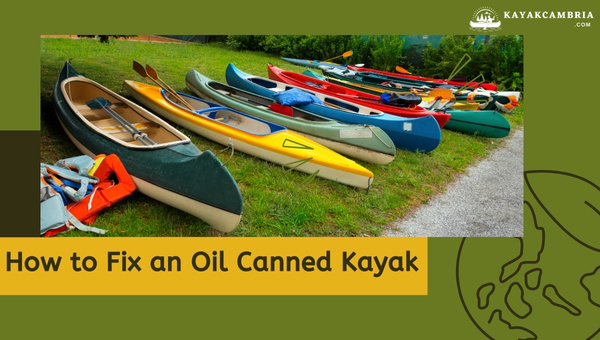
Discovering that your kayak has succumbed to oil canning can be disheartening, especially if you love to hit the water regularly. However, don’t worry – there are some proven strategies that you can use to try and restore your kayak to its original shape. Here’s a step-by-step guide on how to fix an oil canned kayak.
Heat Exposure Method
One of the most effective ways to fix an oil canned kayak is by using the heat exposure method. To do this, follow these steps:
- Place the kayak in a sunny spot, with the dented side facing toward the sun. The heat will help soften the plastic material, making it easier to manipulate.
- Keep an eye on the kayak as the heat works its magic. It might take a few hours for the process to complete, so be patient.
- Once the plastic has softened, gently push on the oil canned area from the inside of the kayak, slowly working the dent back into its original shape. You can also use a blunt object, like a wooden block, to assist in this process.
- After the dent has been restored to its original shape, let the kayak cool down in a shaded area. This will help the plastic material to harden and maintain its new form.
Utilizing Internal Support Structures
Another method to fix oil canning involves using internal support structures, such as foam or inflatable bags, to force the dented area back into shape. Here’s a step-by-step guide:
- Identify the location of the oil canned area on your kayak.
- Insert foam blocks or inflatable bags inside the kayak, directly beneath the affected area.
- Apply pressure on the foam blocks or inflate the bags, taking care not to overdo it, as this may cause further damage to your kayak.
- Leave the supports in place for a few hours, or even a day, to allow the kayak material to reform into its original shape.
- Remove the supports and inspect the results. If the oil canning issue persists, consider repeating the process or trying the heat exposure method.
Remember: Both methods should be carried out with caution. If you’re unsure or uncomfortable attempting any of these techniques yourself, it may be advisable to consult a professional or contact your kayak’s manufacturer for assistance. Nevertheless, with patience and care, you can effectively fix your oil canned kayak and get back to enjoying your time on the water.
Preventing Oil Canning In Kayaks
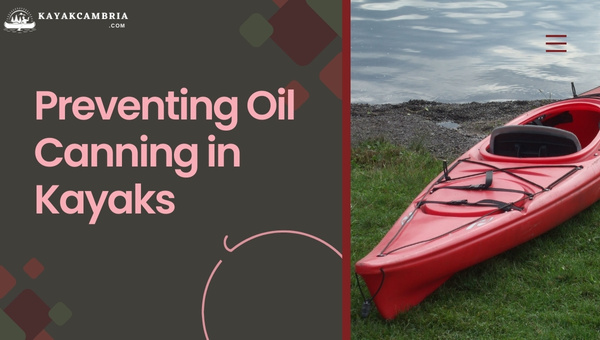
You might be wondering, how do I prevent oil canning in my kayak? Good news! Oil canning is not an inevitable outcome. Preventing oil canning starts with proper handling, storage, and maintenance practices. By following these guidelines, you can extend the lifespan of your kayak and preserve its performance on the water.
Storing Your Kayak Properly
- Store your kayak in a shady, cool area when not in use. Prolonged exposure to sunlight and heat can weaken and warp your kayak’s material.
- Keep the hull supported while storing to prevent it from developing indentations. Use straps, foam padding, or specially designed supports to distribute the weight of the kayak evenly across its hull.
- When possible, store the kayak in an upright position to minimize stress on the hull and prevent deformation.
- Avoid piling heavy objects on top of the kayak. Excessive weight may cause the hull to deform.
Transporting Your Kayak Safely
- When transporting your kayak on a car rack, ensure it is properly secured to avoid deformation from pressure points.
- Use kayak-specific carrying equipment such as foam pads, saddles, or J-hooks that evenly distribute pressure and reduce the risk of oil canning.
Regular Maintenance and Inspection
- Conduct a routine inspection to identify any signs of oil canning or other deformities in your kayak’s hull.
- Clean your kayak regularly to remove dirt, grime, and debris that may contribute to the weakening of the kayak material over time.
Consider Making a Wise Investment
- It is essential to choose a high-quality kayak that is built to last and resist oil canning. Research different kayak models and materials before making your purchase decision. Keep in mind that investing in a durable kayak from a reputable manufacturer may save you money in the long run by preventing the need for repairs or replacement due to oil canning.
By following these guidelines, you can mitigate the risk of oil canning and keep your kayak in optimal shape for your paddling adventures.
Skills And Techniques To Minimize Oil Canning Effects in 2025
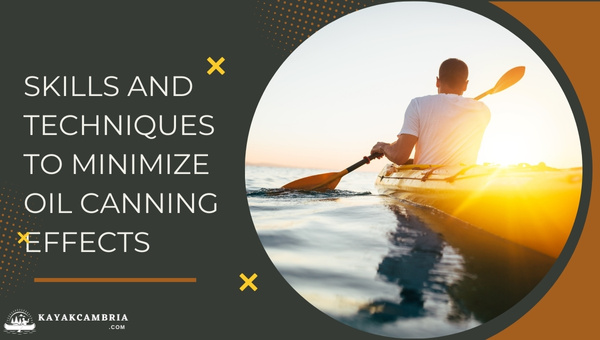
While acquiring a quality kayak and implementing proper storage and maintenance practices can help prevent oil-canning issues, it’s also essential to master certain skills and techniques that reduce its impact on the water. Some key approaches to trying out while paddling include:
Body Positioning
Proper body positioning is crucial to optimize the performance of your kayak. This involves sitting up straight in your kayak and engaging your core muscles. By distributing your weight evenly in the seating area, any local stress on the hull can be minimized, thus reducing the potential of oil canning. Additionally, keep your legs relaxed and feet in contact with the foot braces to enhance control and stability.
Paddling Techniques
Refining your paddling techniques can go a long way in making the most of your oil-canned kayak. Smooth and efficient strokes reduce the drag and improve maneuverability in the water. Some essential strokes to practice include:
- Forward stroke: Ensure an even reach and rotation of the torso, maintaining the paddle at an optimal angle to minimize hull distortion.
- Reverse stroke: Similar to the forward stroke, maintain an even rotation of the torso and utilize the large muscle groups to power the stroke.
- Sweep stroke: This technique helps turn the kayak by using a wide, arcing motion with the paddle, effectively reducing the pressure on the hull.
It’s essential to practice these techniques regularly to become proficient, which will ultimately impact your kayak performance positively.
Recreational Activities
For those using an oil-canned kayak for recreational purposes like touring or fishing, it’s helpful to equip your kayak with additional gadgets and fishing accessories that contribute to greater stability and ease of use. Attaching stabilizers or outriggers can counter the effects of oil canning by providing an extra surface area, negating the distortion and allowing you to better enjoy your on-water experience.
Oil Canning In Different Kayak Types And Materials
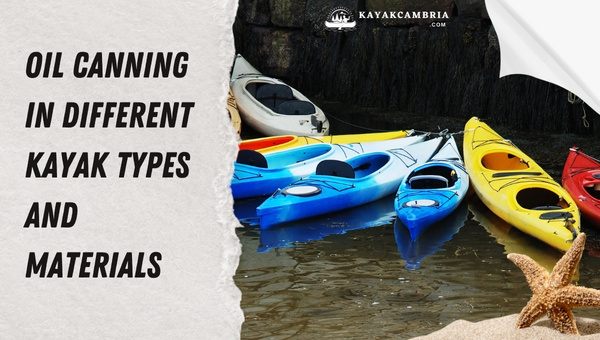
When discussing oil canning, it’s important to acknowledge that different kayak types and materials may exhibit this phenomenon in varying degrees. In this section, let’s delve deeper into the relationship between oil canning and these factors.
Plastic Kayaks
The majority of kayaks today are made from plastic materials such as polyethylene. While these kayaks are generally more affordable and require low maintenance, they are more susceptible to oil canning. This is because plastic tends to be quite flexible, and can be more prone to deformation under stress, heat, or over time.
Composite Kayaks
Composite kayaks are typically crafted from materials like fiberglass, Kevlar, and carbon fiber. Although they tend to be pricier, they are significantly less prone to oil canning due to their rigidity and robust construction. Nonetheless, it is still essential to ensure proper storage and care for these kayaks to preserve their longevity and performance.
Sit-On-Top vs. Sit-Inside Kayaks
In addition to kayak materials, the design and structure of a kayak can also influence its likelihood to experience oil canning. Sit-on-top kayaks, as the name suggests, have an open deck that allows the paddler to sit on top of the kayak. This design generally involves a thicker hull which can provide more resistance to oil canning. However, it’s worth noting that this does not make sit-on-top kayaks completely immune to the issue.
On the other hand, sit-inside kayaks have an enclosed cockpit where the kayaker sits inside the hull. Due to the nature of their design, these kayaks have a deck and hull structure that can make them more vulnerable to oil canning if proper storage and transport precautions are not followed.
Both the type and material of your kayak play a significant role in determining its risk of developing oil canning. While plastic kayaks, particularly sit-inside models, are more susceptible to this issue, proper care and attention can minimize the chances of it occurring. On the flip side, composite and sit-on-top kayaks may be less prone to oil canning, but it is crucial to maintain them properly to ensure a hassle-free and enjoyable kayaking experience.
When To Consider Replacing An Oil-Canned Kayak?

As a kayaking enthusiast, there comes the inevitable moment when you have to decide whether it’s time to replace your oil-canned kayak or try to salvage it. This decision is often influenced by various factors, such as the extent of oil canning damage, how it impacts your kayaking experience, and whether it’s more economical to repair the kayak or purchase a new one. In this section, I will delve deeper into these factors and provide you with the information you need to make an informed decision.
Assessing the Extent of Oil Canning Damage
The first step in deciding whether to replace your oil-canned kayak is to assess the extent of the damage. You can do this through a thorough visual examination as well as by taking your kayak out on the water and observing its performance. If the oil canning is minimal and does not significantly affect your kayak’s efficiency in the water, you might be able to continue using your kayak without issue.
Evaluating the Impact on Your Kayaking Experience
If oil canning starts to impact your kayaking experience, it’s essential to weigh the pros and cons of repairing or replacing it. Factors such as impaired performance, unwanted noise, and stress on the hull should be taken into account. You should also consider your intended use for the kayak – if you mostly engage in light recreational activities, then the impact of oil canning might be negligible. However, if you participate in more demanding outdoor activities, performance and structural integrity may be more crucial factors.
Comparing Repair Costs Vs. Purchasing a New Kayak
Another critical consideration is the cost of repairing your oil-canned kayak compared to the price of a new one. In some cases, the repair process might be more expensive due to the specialized equipment and effort required. Conversely, a new kayak could prove to be a more significant financial investment.
To get a better understanding of the costs involved, it’s helpful to research the average prices for kayak repair services in your area and compare them with the cost of a new kayak that suits your needs.
Warranty Coverage and Manufacturer Support
Lastly, don’t forget to check your kayak’s warranty and the manufacturer’s stance on oil canning. Some manufacturers might offer repair or replacement services if the oil canning is within a specific time frame or deemed beyond acceptable limits. Knowing your manufacturer’s support and coverage can help you decide whether it’s worth repairing or replacing your oil-canned kayak.
Manufacturers’ Take On Oil Canning
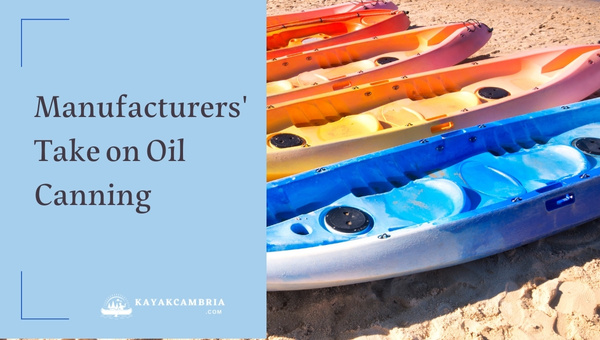
Manufacturers are well aware of the oil canning issue in kayaks, and they are constantly working on improving kayak designs and materials to reduce this problem’s occurrence and impact. Let’s explore their various approaches and perspectives on oil canning.
Materials and Manufacturing Processes
Manufacturers invest time and resources into researching advanced materials and technologies to counteract oil canning. Some companies employ roto-molded or thermoformed methods that offer higher resistance to oil canning. By improving the durability and elasticity of the materials, the likelihood of oil canning can be significantly reduced.
Design Innovations
Changes in hull designs play a vital role in minimizing oil canning. Manufacturers are incorporating chines, flatter hull sections, skegs, and more delicate and feature-rich designs to help kayak enthusiasts enhance their performance and efficiency.
Addressing Quality Control
Apart from scientific and technological advancements in materials and design, companies are also making strides in improving their quality control processes. This step involves implementing robust inspection protocols for detecting and addressing any oil canning concerns before the kayak ships to the customer.
Warranty and Customer Support
Warranties are often provided by manufacturers to guarantee the quality of their products. Determining whether a specific warranty covers oil canning-related damages can be a crucial factor for buyers. It’s essential to check and clarify the warranty terms with the company before purchasing. Some manufacturers might also offer repair services or replacement for severe oil canning cases.
Kayak Care Advice
Leading manufacturers actively engage with their customers, providing advice on oil canning prevention and remedies. They suggest the proper storage, maintenance, handling, and transportation practices, which can be found in the owner’s manual or on the manufacturer’s website.
Ultimately, manufacturers are well aware that addressing oil canning is crucial to their success. By improving materials, designs, and quality control processes, they are striving to offer innovative and long-lasting products on the market. While it cannot guarantee the complete elimination of oil canning, their investment and commitment to improvement help reduce the likelihood and impact of this common kayak concern.
Frequently Asked Questions
1. What is the main cause of oil canning in kayaks?
Oil canning occurs primarily due to external pressure and heat exposure. These may result from improper storage, transportation, or usage of the kayak. Kayaks made from thinner and less rigid materials and those with large, unsupported flat areas are more susceptible to oil canning.
2. Can oil canning be fixed or is it permanent?
In many cases, oil canning can be fixed through various methods. Some of these methods include:
1. Gradually applying heat to the affected area and allowing the material to return to its original shape
2. Using internal support structures to provide additional support and reshape the hull
3. Carefully forcing the hull back into its original shape through manual manipulation
3. How can I prevent oil canning in my kayak?
To prevent oil canning, it is crucial to follow proper storage and transportation practices. These include:
A. Storing your kayak in a cool, shaded area
B. Ensuring adequate support during transportation by using well-padded kayak racks
C. Regularly inspecting and maintaining your kayak
D. Investing in a high-quality, durable kayak to minimize the risk of oil canning
4. How does oil canning affect different types of kayaks and materials?
Generally, plastic kayaks are more prone to oil canning than composite kayaks, such as those made from fiberglass or carbon fiber. This is mainly due to their softer and more flexible material. However, composite kayaks can also experience oil canning, albeit at a lower rate.
Sit-on-top kayaks and sit-inside kayaks can both experience oil canning, with the occurrence rate mainly dependent on the quality of their materials, design, and construction.
5. Does oil canning have a significant impact on the performance of my kayak?
While oil canning may not have a severe impact on your kayaking experience, it can still somewhat affect the performance of your kayak. An oil-canned kayak can be less efficient in the water and potentially create added stress points that may lead to cracks or other damage over time.
6. Will manufacturers replace or repair a kayak with oil canning?
Manufacturers usually provide warranties on their kayaks, but whether oil canning is covered under warranty depends on the specific manufacturer’s policy. Some manufacturers recognize oil canning as a warranty issue and may offer repair or replacement services, while others see it as a result of improper usage, transportation, or storage and may not cover it under warranty. It’s essential to review your manufacturer’s warranty terms and consult with them directly if your kayak experiences oil canning.
Conclusion
Oil canning is an issue that affects many kayakers, particularly those using plastic kayaks. While it may not be widely discussed, understanding the phenomenon is crucial to maintaining optimal performance and prolonging the life of your kayak. Proper storage, transportation, and paddling techniques can help prevent and minimize the effects of oil canning. And, knowing how and when to repair or replace an oil-canned kayak is essential for a seamless kayaking experience.
Remember to invest in a high-quality, durable kayak and always keep an eye on its condition. Don’t be afraid to seek advice from manufacturers or fellow kayakers when dealing with oil canning. Above all, do not let this phenomenon dampen your enthusiasm for kayaking. With proper care and maintenance, you can continue enjoying this incredible water activity for years to come. Happy paddling!

